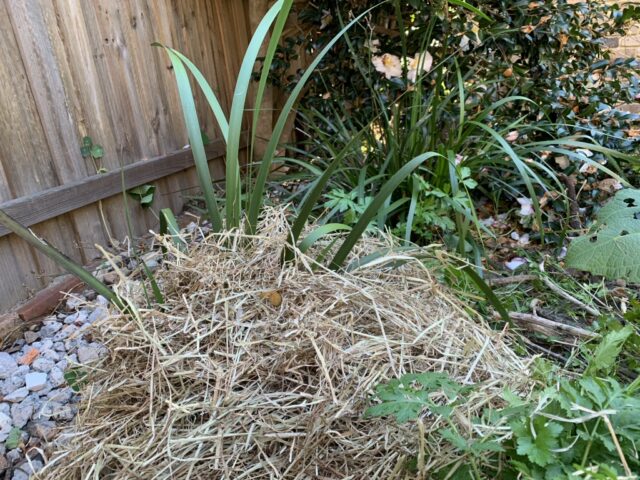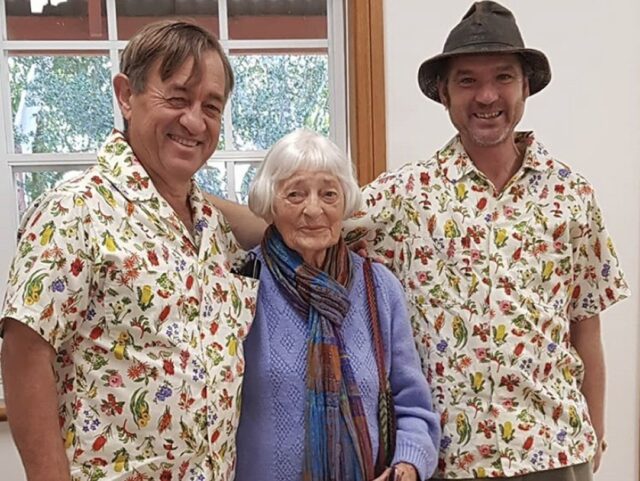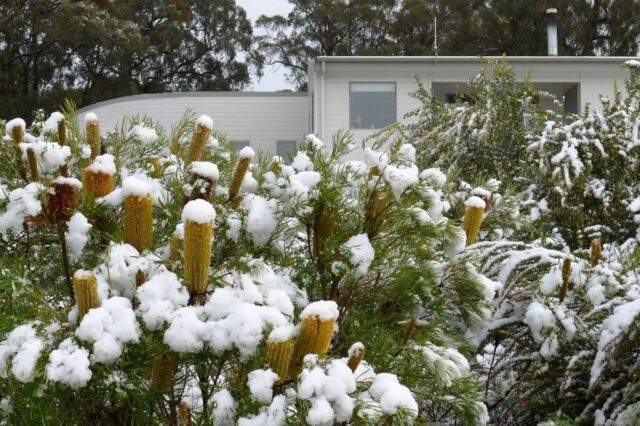Mad About Dirt:
What a fun weekend event this was, starting at Narara Valley high school on the Central Coast NSW and then heading to Narara Eco Village for the afternoon session and a more in depth session on Sunday. The weekend was dedicated to dirt and learning more about this amazing substance that we sometimes overlook and take for granted. It was great to see so many people attending to learn more about the soil beneath their feet… a living and miraculous carpet of life! There was lots to see and do at this event and many individuals full of knowledge and expertise in the area of gardening and soil. It was a privilege to be speaking along side the likes of my good friend Tino Carnevale and also soil scientist and co-author of ‘Grow Your Own,’ Simon Leake. The Sunday part of the weekend was Mothers Day, so I invited my 95 year old mum Audrey to be a part of it….she made the day even more special by making matching shirts for Tino and I!
It was also great to return to the place where I got my first job after leaving university. The Eco Village was formerly a government owned agricultural research station, and has loads of history, as well as bordering on Strickland State Forest which is home to the first government forest nursery where planting of native and exotic trees began in 1886. This arboretum is among the oldest in Australia and is worth exploring, as it has great tracks…..walking amongst the mature trees is a walk in nature’s cathedral, every bit as awe inspiring as any man made structure, and just as fragile. The memory of the burning of Notre Dame was fresh as we walked through the trees on Sunday. The arboretum is a beautiful team effort of man and nature working together, and well worth a visit if you are on the NSW central coast.
When the research station was put up for sale, it was feared that it would disappear under more bland suburbia, but an ambitious Eco Village is now being created on the site. It is quite exciting to see that they are creating their own smart grid, water treatment works and energy efficient housing. Projects like this show the way that things can be done to put society on a more sustainable footing. So it was apt that they put on a weekend dedicated to soil and all the life that springs from it.
As the developing world progresses and mass farming becomes more prevalent, many people becoming more aware and active in seeking out alternative and more sustainable ways to source and also grow their own food. I found it really inspiring to meet so many people who are both mindful and motivated to live their life with a more positive environmental impact. People who were open to learning more about things like growing their own edible produce, composting and using water conservatively and also how all these things can go hand in hand with living a healthier life. The more edible produce we can grow in our own back yard, the healthier our bodies can become! And the more we harvest from our own back yard, the more likely we are to have scraps to feed our worms/composting bins, from which we can harvest valuable gardening materials to nourish our edibles and grow even more produce, which we can then use to nourish our own bodies! And so the cycle continues! It’s all about turning food miles into food footsteps for both ourselves and the greater good of the Earth. As more and more people begin to grow their own edibles in their back yards, the soil can begin to repair and lessen the damage that may have been done from the use of harmful pesticides and herbicides. Chemicals such as these may be seen as gardening aids by killing the insects which can attack crops and also control ‘weeds’ that may pop up, however, it’s important to note that these chemicals also not only may kill pollinators and other insects, they also cause great harm to microorganisms within the soil. But let’s not let this information dishearten us, lets use it to inspire a different way of thinking. Let’s turn our own backyards into safe havens for soil dwellers and insects alike! In doing so we will also be creating good growing environments for our edible produce. The Mad About Dirt event was one which not only encouraged this way of thinking, but it also gave practical solutions to making this way of life work. Tino Carnevale really struck a chord with me in relation to the issue of top soil. It has been said it can take up to 100 years for top soil to build up, but Tino made a great point when we said that we can do it much quicker than that with composting and worm farming practices. Using every scrap of compostable material for our gardens instead of sending to landfill is something we all should aspire to. This is inspiring and motivating stuff! I will share tips on sustainable living and soil building in next month’s newsletter. If you can’t wait for that, then start delving into some of my articles on soil building>>>>>
I had my niece and sister there with me to run the ‘Gardening With Angus’ stall and she also wanted to share these words about the day:
“As a Mum of two youngsters I was left feeling really inspired by the Mad About Dirt event. The speakers there gave some really motivational talks and offered a ton of practical advice about growing organic edible produce and reducing our individual environmental impacts through practices such as composting. I have a worm farm myself for the kitchen scraps, but after attending the Mad About Dirt event I learnt how to delve a little deeper with composting and worm farming and how to use some of these practices to aid in growing edible produce. I now think more about the dirt beneath my feet and the little organisms living within. I feel a sense of obligation to do my bit to protect and care for these organisms and in doing so I can help create a better future for my own children. I want my kids to grow up with composting and home food growing as a norm. I want them to think the idea of sending biodegradable produce to landfill is ridiculous. I want them to be in the garden, getting their hands dirty and be involved with growing the foods that they can then harvest with their own hands and eat. The Mad About Dirt event gave me some great information to really ramp up what I’m doing and put more of this knowledge into practice.
It was a really fun day working on the Gardening With Angus stall and hearing such great feedback on his books and cards! Many copies of ‘Grow Your Own-How To Be An Urban Farmer’ were sold and the people buying them were excited to learn more about growing their own edibles. It was great to talk to a range of people from garden beginners, to experienced gardeners and also some young upcoming horticulturists who have been inspired by Angus for years! I was also happy to hear all the beautiful feedback on the Daisy Wood cards , which Angus created from the art of his grandmother (and my great grandmother!). The cards were a big hit and this filled me with a sense of pride to be part of a family so talented and dedicated to Australian plants! Over all, it was a wonderful event and I’d like to thank Narara Eco Village for making it all possible.”
For those of you who attended ‘Mad About Dirt,’ I’d like to personally thank you for coming! For those who may have missed out, keep your eyes on my website and social media, website and of course this newsletter for future events that I might be attending in your area. While we are on that subject, this upcoming weekend (1st & 2nd of June) I will be at Brisbane Plant Collectors Fair, talking on the topic of free fertiliser: making your own perfectly balanced plant food. There will be some other inspiring speakers there too including Gardening Australia’s Jerry Coleby-Williams. The Plant Collectors Fair is a great opportunity to pick up rare and interesting plants that can otherwise be hard to find. Be sure to bring a cardboard box to put your new plants into (and of course to put into the worm farm/compost later when you get home) as the event will be plastic bag free.
Winter Care Of Kangaroo Paws For Colder Areas:
As autumn comes to an end and winter is upon us, I’d like to give everyone who lives in the chillier parts of Australia some tips on kangaroo paw care. I can never guarantee that plants will survive through the more severe winter conditions, but I can say that the taller kangaroo paws are much more able to withstand heavy frost and snow due to their larger underground rhizome and more robust growth habit. With this in mind though, I would like to share some useful information that may help give your kangaroo paws the best chance of surviving the cold.
If you do not have a kangaroo paw in your garden and you are thinking of adding one, unless you are in low frost or frost free places, wait until after winter to plant. A plant that is well established in the garden has much better chance of surviving a hard frost than one which has been freshly planted. Kangaroo paws like a bit of extra care when they have just been planted out and tend to have lovely fresh green shoots. Frost has a tendency to damage these softer new shoots and also any flower buds, so hold off planting a new paw until winter is over. Though it is possible to plant into pots that can be kept in an area that has a microclimate that is less affected by freezing temperatures, like sunny courtyards and against walls.
If you only get occasional frosts, then it is worth knowing that frost damages plants when the frozen plant tissues thaw very quickly, as this explodes the cell walls. If you can get to your plants before the sun hits them, it is helpful to douse them with cold water, which thaws the plant more slowly.
I have previously shared pictures of a friend’s garden in one of the coldest areas of NSW, with her Banksias and tall paws covered in snow. I really liked her way of dealing with the kangaroo paws that tend to end up frozen and black, so I will repeat it. ‘If you have kangaroo paws in the garden and they die right back as a result of heavy frost or snowfall, wait until the danger of further snow and heavy frosts are over before you do anything. Kangaroo paws have an underground rhizome and there’s a good chance it has survived and will reshoot in the warmer weather. The blackened leaves help protect the plant.’ The pictures are in Newsletter #18.
Some cold weather growers use a layer of straw to help protect the rhizome from icy conditions. If you live in an area that is prone to frost, I highly recommend doing this. The straw acts as an insulating blanket.

In colder areas most species are dormant or very slow growing over winter (some die back completely). So if you notice little to no growth over Winter don’t panic, this is normal. It is also really important not to give your paw too much water at this time. Equally important, if the plant is dormant, don’t fertilise until conditions begin warming.
The ACT is an area that gets very cold frosty winters. The Botanic Gardens in the ACT explained how they care for their kangaroo paws during Winter: “Kangaroo paws are cut back to within about 10 cm of the ground in late winter. In this way diseased and frost damaged leaves are removed, reducing the chance that they will harbour pests and diseases.” I like this advice from them and I think it’s also to remember the second sentence and apply it the warmer months. If your kangaroo paw shows signs of disease or dead leaves/flower stems, it is best to remove them from the plant. This not only helps minimise spread of possible disease to the rest of the paw, but it also makes way for new growth! i have a whole separate article on this topic on my website for those interested.
My article on kangaroo paws gives more tips, plus information about the different varieties. They have evolved to be tough plants, and with a little bit of extra care, they truly are one of the most magnificent plants Australia has to offer!


